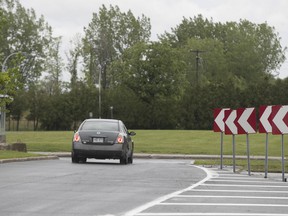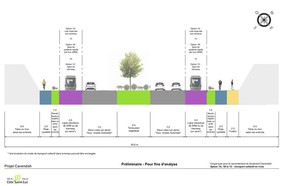After more than 50 years of talking about it, the city of Montreal this week took the first concrete step to carry out the extension of Cavendish Blvd.

Article content
After more than 50 years of talking about it, the city of Montreal this week took the first concrete step to carry out the extension of Cavendish Blvd.
advertisement
This advertisement has not loaded yet, but your article continues below.
Article content
The administration of Mayor Valérie Plante mailed a notice of project to the provincial environment department on Tuesday, officially the first move in Quebec’s environmental impact review process. The assessment, which is to be carried out by the Bureau d’audiences publiques sur l’environnement (BAPE), is required before the city can put a shovel in the ground.
“We really want to do a project that is exemplary on all levels, a project that will respect the higher standards of sustainable development,” Sophie Mauzerolle, the city executive committee member responsible for transportation and mobility, said on Friday. (The Quebec environment department requires the notice of project and the accompanying documentation be sent by mail, Mauzerolle said.)
advertisement
This advertisement has not loaded yet, but your article continues below.
Article content
“It used to be a highway project. We want it to be first a public transit project with active mobility and green spaces.”
The next step will be for the city to publish a notice of the project in newspapers and allow the public to ask questions. The environment department will then ask the city to carry out any number of impact studies.
“We’ll do them diligently, but as fast as we can,” Mauzerolle said of the studies, which she said have to be done before the BAPE holds public hearings on the project.
The project notice to the environment department pegs the start of construction of the Cavendish extension as 2027, said Marikym Gaudreault, a spokesperson for the Plante administration.

Construction of a north-south link to join the two parts of Cavendish across a rail yard at the end of Royalmount Ave. west of Décarie Expressway has been talked about since the mid-1960s, and studied in the 1980s, 1990s and early 2000s. Montreal even opened a project office in 2004.
advertisement
This advertisement has not loaded yet, but your article continues below.
Article content
Connecting the two parts, which are in Côte-St-Luc and St-Laurent borough, through the rail yard is considered essential to alleviating congestion on Décarie.
But Montreal also has a contractual obligation to complete the Cavendish extension so it can build a promised carbon-neutral housing project on the Blue Bonnets-Hippodrome site next to Décarie and Jean-Talon St. The province ceded the site to Montreal in 2017 with that caveat. The contract with the province also requires the city to do the traffic and impact studies for the Cavendish extension by June.
The last time Montreal sent anything to the BAPE — in 2005 — it concerned the Cavendish project, Côte-St-Luc city councilor Dida Berku and St-Laurent borough mayor Alan DeSousa recalled. It’s an indication of how painfully long it has been to get the extension built, they said.
advertisement
This advertisement has not loaded yet, but your article continues below.
Article content
“The project has been in hibernation,” DeSousa said.
Berku said the 2006 municipal demergers put the kibosh on any new road project for the west end of the island.
While mayors in the Cavendish corridor — Côte-St-Luc, St-Laurent and Town of Mount Royal — said they’re pleased that Montreal has launched the environmental review process, a major disagreement remains on how many lanes to provide for cars and trucks in the project.
The west-end mayors expressed surprise in October when Plante declared her intention to build one lane for vehicles in each direction of the Cavendish extension.
“A single lane on either side is limiting,” Peter Malouf, the newly elected mayor of TMR, said on Friday. “It does not make sense to me.”
advertisement
This advertisement has not loaded yet, but your article continues below.
Article content
Côte-St-Luc Mayor Mitchell Brownstein said the three mayors agree that the 50-metre-wide parcel should include two bike paths, a pedestrian path, green buffers and dedicated lanes for rapid mass transit. But they also agree it can and should include two lanes for motorists in either direction, he said.
“People will definitely take advantage of those options,” Brownstein said of the bike and walking paths and public transit corridor. “But there are other people who don’t have the ability to do that.”
Over 30 per cent of the population of Côte-St-Luc is 65 or older, he said.
“It’s a good first step, but clearly I would have hoped for at least a consensus with regard to the project,” DeSousa said.
“It seems to me to be an awful lot of money to be spent on Cavendish to have one lane. A simple truck breakdown could cause bottlenecks and traffic jams.”
However, Mauzerolle said the number of lanes isn’t settled.
“The BAPE process will allow us to refine the configuration,” she said. “There are places where there could be two lanes.”
-
Montreal’s west-end mayors question Plante’s Cavendish extension plan
-
Côte-St-Luc asks city to move forward on Cavendish Blvd. extension

